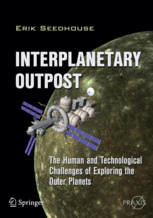While many visionaries now focus upon Mars as the next destination for humankind to visit, some have an even longer view. In the book, “Interplanetary Outpost: The Human and Technological Challenges of Exploring the Outer Planets,” you can take a ride with the author Erik Seedhouse to possibly the next most habitable body in our solar system. You can visit Callisto in the Jovian system. However, on reading this book you will quickly discover that it won’t be a simple journey there and back again.
Imagine yourself wanting to get involved with that first trip to Callisto. What would you do? Where would you begin? Well, this book could be a really good high level overview for the requirements for your endeavour.
First, it reminds you on why Callisto is the best target. Here it draws upon earlier NASA efforts, including RASC-Revolutionary Aerospace Systems Concepts and HOPE-Human Outer Planet Exploration. It also continually references recent movies like Avatar and Pandorum as supporting work. With the references aside, the book settles down and focuses you upon its prime directive, a one-off exploration endeavor, even smaller than the multiple missions of Apollo to the Moon. Therefore, much of the book’s information serves to satisfy this one-off.
As you read, you will discover more and more requirements and pre-conditions. For example, according to this book, you will be departing from a spaceport parked in CIS-Lunar orbit. You will travel on the optimal path to arrive at Callisto without hitting Jupiter or being affected by its radiation fields. You will use electrical onboard power from a nuclear generation system. Your craft will be powered by a variable specific impulse magnetoplasma rocket. Your body will be suspended cryogenically on the flight. Your body will be filled with nano-biomechanical devices so that you are in functional shape when you arrive. An onboard computer (not named HAL) will sustain both your sleeping body and the spacecraft on its multiyear journey. And so the book’s list of pre-conditions continues on. Thus, as you can well imagine, the book takes you along a path that perhaps is more akin to science fiction than science fact even though it argues that the technologies are all nearly-here! Topping this list is the submersible that launches you into the ice-covered oceans of Callisto. In any case, humankind will have to do a huge amount of prior development before you ever get to this Jovian moon; at least according to this book.
The book’s reliance upon un-proven or even non-existent technology is what will likely either make or break it for you. In effect, the book reads as if the author accumulated a large number of scientific research papers and turned them into a comprehensive, very entertaining prose for the general audience. If you want to be entertained, then this book is for you. If you want to get into a bit more of the nitty gritty, well then you may be less entertained. For example, the book has an expectation that explorers on Callisto will utilize GPS receivers to help them navigate. But, there is no mention of a GPS satellite constellation orbiting Callisto. And what about cryogenics? While the book does mentions some ongoing research today, we certainly don’t consider it mainstream. You may learn of new words like ‘respirocytes’. This knowledge could serve you well at cocktail parties but may not get you much headway at the next meeting of the local astronomical society. So, this reliance upon un-proven or non-existent technology should be kept in mind before you read this book.
However, at one time, some people were imaginative enough, or brave enough, to envision humankind doing more than staying upon planet Earth. Sure the Moon is close and Mars is apparently only slightly further. But there’s a whole universe out there just waiting for us. Are you sure what might be the best path for our species? Take a read of Erik Seedhouse’s book “Interplanetary Outpost – The Human and Technological Challenges of Exploring the Outer Planets”. It might change your perspective as it takes you on a ride the likes of which will never have been seen on Earth before.
This book is available from Springer.
Learn more about the author Erik Seedhouse at Astronauts4Hire.org


Cryogenics is over the top for going to Callisto. The fuel optimal transfer directly from Earth to Jupiter takes only about 2 years 8 months. So it would be a 6 years mission. Many crews have spent more than that away from home while sailing the seas to unknown countries before mobile engines were commonplace. With virtual reality and a gym a suitably recruited and trained crew could spend that time in an ISS sized spaceship without suffering any strange space madness. But Jupiter is kind of the limit for that conventional approach.
A human trip to Saturn would be a 13 year long trip. But if it requires a permanent settlement at Jupiter, then the launch windows are only once every 20 years. That’s how long the first crew would have to spend going to Saturn, staying there, and going back to Jupiter. That’s a long time in a human life, but even marriages which brings up teenagers do last that long, so there’s at least no psychological argument against it 🙂
And why Callisto instead of Ganymede, which is the only moon that has its own protective magnetic field? ESA’s JUICE mission will orbit Ganymede for that reason. But I suppose it is explained in the book which I haven’t got yet.
Here’s a link to a few slides with some data and explanation in few words:
http://www.yorku.ca/jjshan/phys4110/notes_files/PHYS4110_Dynamics_9_Interplanetary_Trajectories.pdf